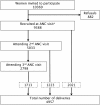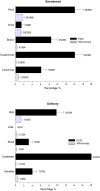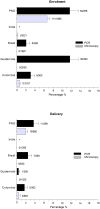Burden and impact of Plasmodium vivax in pregnancy: A multi-centre prospective observational study
- PMID: 28604825
- PMCID: PMC5481034
- DOI: 10.1371/journal.pntd.0005606
Burden and impact of Plasmodium vivax in pregnancy: A multi-centre prospective observational study
Abstract
Background: Despite that over 90 million pregnancies are at risk of Plasmodium vivax infection annually, little is known about the epidemiology and impact of the infection in pregnancy.
Methodology and principal findings: We undertook a health facility-based prospective observational study in pregnant women from Guatemala (GT), Colombia (CO), Brazil (BR), India (IN) and Papua New Guinea PNG). Malaria and anemia were determined during pregnancy and fetal outcomes assessed at delivery. A total of 9388 women were enrolled at antennal care (ANC), of whom 53% (4957) were followed until delivery. Prevalence of P. vivax monoinfection in maternal blood at delivery was 0.4% (20/4461) by microscopy [GT 0.1%, CO 0.5%, BR 0.1%, IN 0.2%, PNG 1.2%] and 7% (104/1488) by PCR. P. falciparum monoinfection was found in 0.5% (22/4463) of women by microscopy [GT 0%, CO 0.5%, BR 0%, IN 0%, PNG 2%]. P. vivax infection was observed in 0.4% (14/3725) of placentas examined by microscopy and in 3.7% (19/508) by PCR. P. vivax in newborn blood was detected in 0.02% (1/4302) of samples examined by microscopy [in cord blood; 0.05% (2/4040) by microscopy, and 2.6% (13/497) by PCR]. Clinical P. vivax infection was associated with increased risk of maternal anemia (Odds Ratio-OR, 5.48, [95% CI 1.83-16.41]; p = 0.009), while submicroscopic vivax infection was not associated with increased risk of moderate-severe anemia (Hb<8g/dL) (OR, 1.16, [95% CI 0.52-2.59]; p = 0.717), or low birth weight (<2500g) (OR, 0.52, [95% CI, 0.23-1.16]; p = 0.110).
Conclusions: In this multicenter study, the prevalence of P. vivax infection in pregnancy by microscopy was overall low across all endemic study sites; however, molecular methods revealed a significant number of submicroscopic infections. Clinical vivax infection in pregnancy was associated with maternal anemia, which may be deleterious for infant's health. These results may help to guide maternal health programs in settings where vivax malaria is endemic; they also highlight the need of addressing a vulnerable population such as pregnant women while embracing malaria elimination in endemic countries.
Conflict of interest statement
The authors have declared that no competing interests exist.
Figures



Similar articles
-
Meta-analysis of the prevalence of malaria associated with pregnancy in Colombia 2000-2020.PLoS One. 2021 Jul 30;16(7):e0255028. doi: 10.1371/journal.pone.0255028. eCollection 2021. PLoS One. 2021. PMID: 34329329 Free PMC article.
-
Plasmodium vivax VIR Proteins Are Targets of Naturally-Acquired Antibody and T Cell Immune Responses to Malaria in Pregnant Women.PLoS Negl Trop Dis. 2016 Oct 6;10(10):e0005009. doi: 10.1371/journal.pntd.0005009. eCollection 2016 Oct. PLoS Negl Trop Dis. 2016. PMID: 27711158 Free PMC article.
-
Microscopic and submicroscopic Plasmodium falciparum infection, maternal anaemia and adverse pregnancy outcomes in Papua New Guinea: a cohort study.Malar J. 2019 Sep 2;18(1):302. doi: 10.1186/s12936-019-2931-7. Malar J. 2019. PMID: 31477117 Free PMC article. Clinical Trial.
-
Plasmodium vivax Malaria in Pregnant Women in the Brazilian Amazon and the Risk Factors Associated with Prematurity and Low Birth Weight: A Descriptive Study.PLoS One. 2015 Dec 16;10(12):e0144399. doi: 10.1371/journal.pone.0144399. eCollection 2015. PLoS One. 2015. PMID: 26675007 Free PMC article.
-
Epidemiology and burden of malaria in pregnancy.Lancet Infect Dis. 2007 Feb;7(2):93-104. doi: 10.1016/S1473-3099(07)70021-X. Lancet Infect Dis. 2007. PMID: 17251080 Review.
Cited by
-
Quantifying and preventing Plasmodium vivax recurrences in primaquine-untreated pregnant women: An observational and modeling study in Brazil.PLoS Negl Trop Dis. 2020 Jul 31;14(7):e0008526. doi: 10.1371/journal.pntd.0008526. eCollection 2020 Jul. PLoS Negl Trop Dis. 2020. PMID: 32735631 Free PMC article.
-
Meta-analysis of the prevalence of malaria associated with pregnancy in Colombia 2000-2020.PLoS One. 2021 Jul 30;16(7):e0255028. doi: 10.1371/journal.pone.0255028. eCollection 2021. PLoS One. 2021. PMID: 34329329 Free PMC article.
-
Cost-effectiveness of rapid diagnostic tests, compared to microscopic tests, for the diagnosis and treatment of gestational malaria in Colombia from an institutional perspective.Malar J. 2020 Nov 10;19(1):400. doi: 10.1186/s12936-020-03472-6. Malar J. 2020. PMID: 33172472 Free PMC article.
-
Malaria in pregnancy in India: a 50-year bird's eye.Front Public Health. 2023 Oct 19;11:1150466. doi: 10.3389/fpubh.2023.1150466. eCollection 2023. Front Public Health. 2023. PMID: 37927870 Free PMC article.
-
Clinical impact of vivax malaria: A collection review.PLoS Med. 2022 Jan 18;19(1):e1003890. doi: 10.1371/journal.pmed.1003890. eCollection 2022 Jan. PLoS Med. 2022. PMID: 35041650 Free PMC article.
References
-
- Guerra CA, Snow RW, Hay SI: Mapping the global extent of malaria in 2005. Trends Parasitol 2006, 22(8):353–358. doi: 10.1016/j.pt.2006.06.006 - DOI - PMC - PubMed
-
- Hay SI, Guerra CA, Tatem AJ, Noor AM, Snow RW: The global distribution and population at risk of malaria: past, present, and future. Lancet Infect Dis 2004, 4(6):327–336. doi: 10.1016/S1473-3099(04)01043-6 - DOI - PMC - PubMed
-
- Baird JK: Neglect of Plasmodium vivax malaria. Trends Parasitol 2007, 23(11):533–539. doi: 10.1016/j.pt.2007.08.011 - DOI - PubMed
-
- Mueller I, Galinski MR, Baird JK, Carlton JM, Kochar DK, Alonso PL, del Portillo HA: Key gaps in the knowledge of Plasmodium vivax, a neglected human malaria parasite. Lancet Infect Dis 2009, 9(9):555–566. doi: 10.1016/S1473-3099(09)70177-X - DOI - PubMed
Publication types
MeSH terms
Grants and funding
LinkOut - more resources
Full Text Sources
Other Literature Sources
Miscellaneous

